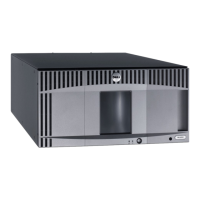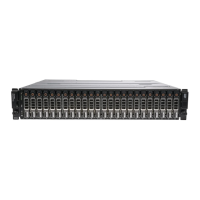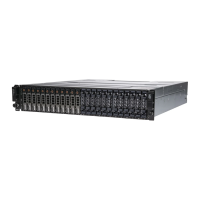








Do you have a question about the Dell PowerVault ML6000 and is the answer not in the manual?
Provides an overview of the manual's content and scope.
Identifies the target audience for the user's guide.
Explains typographic conventions and terminology used throughout the document.
Highlights potential damage to programs, devices, systems, or data.
Lists other Dell publications for more information.
Directs users to Dell's online support resources.
Details the main components of the Encryption Key Manager.
Explains the process and methods of managing tape encryption.
Describes encryption managed by backup applications.
Describes encryption managed by the Encryption Key Manager via the library.
Explains encryption key types, generation, and usage.
Provides a checklist of tasks for setting up encryption.
Outlines essential tasks for configuring the Encryption Key Manager.
Details requirements for library-managed tape encryption.
Lists the necessary hardware and software for the system.
Highlights the importance of preserving keystore data.
Provides critical instructions for backing up keystore data for recovery.
Describes single-server and two-server configurations for the key manager.
Addresses FIPS 140-2 certification requirements for cryptographic providers.
Provides step-by-step instructions for installing EKM on Linux.
Provides step-by-step instructions for installing EKM on Windows.
Details using the GUI to create configuration files, keystores, and certificates.
Explains how to generate encryption keys and aliases for LTO drives.
Covers organizing symmetric keys into key groups.
Explains automatic addition of new drives to the drive table.
Details methods for synchronizing data between key manager servers.
Guides on managing the lifecycle of the key manager server.
Explains how to use the CLI client for managing EKM.
Lists and describes available commands for the CLI client.
Identifies key files for troubleshooting server startup issues.
Provides steps to diagnose and resolve communication issues between client and server.
Lists common errors reported by EKM and their solutions.
Describes the audit subsystem and its record generation.
Details parameters for configuring audit log behavior.
Explains the structure and format of audit records.
Explains how to query the metadata XML file using EKMDataParser.
Provides steps to recover corrupted metadata files.
Offers example EKM properties files for configuration.
Details properties for the EKM server configuration file.
Details properties for the EKM CLI client configuration file.
Explains how expired certificates affect reading encrypted tapes.
Discusses certificate renewal and its impact on the Encryption Key Manager.
Lists trademarks used in the document.
Provides an overview of the manual's content and scope.
Identifies the target audience for the user's guide.
Explains typographic conventions and terminology used throughout the document.
Highlights potential damage to programs, devices, systems, or data.
Lists other Dell publications for more information.
Directs users to Dell's online support resources.
Details the main components of the Encryption Key Manager.
Explains the process and methods of managing tape encryption.
Describes encryption managed by backup applications.
Describes encryption managed by the Encryption Key Manager via the library.
Explains encryption key types, generation, and usage.
Provides a checklist of tasks for setting up encryption.
Outlines essential tasks for configuring the Encryption Key Manager.
Details requirements for library-managed tape encryption.
Lists the necessary hardware and software for the system.
Highlights the importance of preserving keystore data.
Provides critical instructions for backing up keystore data for recovery.
Describes single-server and two-server configurations for the key manager.
Addresses FIPS 140-2 certification requirements for cryptographic providers.
Provides step-by-step instructions for installing EKM on Linux.
Provides step-by-step instructions for installing EKM on Windows.
Details using the GUI to create configuration files, keystores, and certificates.
Explains how to generate encryption keys and aliases for LTO drives.
Covers organizing symmetric keys into key groups.
Explains automatic addition of new drives to the drive table.
Details methods for synchronizing data between key manager servers.
Guides on managing the lifecycle of the key manager server.
Explains how to use the CLI client for managing EKM.
Lists and describes available commands for the CLI client.
Identifies key files for troubleshooting server startup issues.
Provides steps to diagnose and resolve communication issues between client and server.
Lists common errors reported by EKM and their solutions.
Describes the audit subsystem and its record generation.
Details parameters for configuring audit log behavior.
Explains the structure and format of audit records.
Explains how to query the metadata XML file using EKMDataParser.
Provides steps to recover corrupted metadata files.
Offers example EKM properties files for configuration.
Details properties for the EKM server configuration file.
Details properties for the EKM CLI client configuration file.
Explains how expired certificates affect reading encrypted tapes.
Discusses certificate renewal and its impact on the Encryption Key Manager.
Lists trademarks used in the document.
| Type | Tape Library |
|---|---|
| Drive Types | LTO-4, LTO-5, LTO-6 |
| Connectivity | SAS |
| Interface | SAS |
| Management Interface | Web-based |
| Tape Technology | LTO |
| Scalability | Scalable to multiple libraries |











